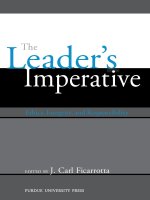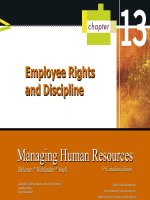Dessler HRM 12e ch 014 ethics jusstic and fair treatment
Bạn đang xem bản rút gọn của tài liệu. Xem và tải ngay bản đầy đủ của tài liệu tại đây (1022.76 KB, 56 trang )
Chapter 14
Ethics, Justice,
and Fair Treatment
in HR Management
Part Five | Employee Relations
Copyright © 2011 Pearson Education, Inc.
publishing as Prentice Hall
PowerPoint Presentation by Charlie Cook
The University of West Alabama
WHERE WE ARE NOW…
Copyright © 2011 Pearson Education, Inc. publishing as Prentice Hall
14–2
LEARNING OUTCOMES
1. Explain what is meant by ethical behavior at work.
2. Discuss important factors that shape ethical behavior
at work.
3. Describe at least four specific ways in which HR
management can influence ethical behavior at work.
4. Employ fair disciplinary practices.
5. List at least four important factors in managing
dismissals effectively.
Copyright © 2011 Pearson Education, Inc. publishing as Prentice Hall
14–3
Ethics and Fair Treatment at Work
• The Meaning of Ethics
The principles of conduct governing
an individual or a group.
The standards you use to decide
what your conduct should be.
Ethical behavior depends on
a person’s frame of reference.
• Ethical Decisions
Normative judgments
Morality
Copyright © 2011 Pearson Education, Inc. publishing as Prentice Hall
14–4
FIGURE 14–1
Online Ethics Quiz
Copyright © 2011 Pearson Education, Inc. publishing as Prentice Hall
14–5
TABLE 14–1
Specific Observed Unethical Behaviors
Abusive or intimidating behavior toward employees
21%
Lying to employees, customers, vendors, or to the public
19%
A situation that places employee interests over organizational interests
18%
Violations of safety regulations
16%
Misreporting of actual time worked
16%
E-mail and Internet abuse
13%
Discrimination on the basis of race, color, gender, age, or similar categories
12%
Stealing or theft
11%
Sexual harassment
9%
Provision of goods or services that fail to meet specifications
8%
Misuse of confidential information
7%
Alteration of documents
6%14–6
Copyright © 2011 Pearson Education, Inc. publishing as Prentice Hall
Ethics and the Law
A behavior may be legal
but unethical.
Ethics and
Behaviors
A behavior may be illegal
but ethical.
A behavior may be both
legal and ethical.
A behavior may be both
illegal and unethical.
Copyright © 2011 Pearson Education, Inc. publishing as Prentice Hall
14–7
Ethics, Fair Treatment, and Justice
Components of Organizational Justice
Distributive justice
Copyright © 2011 Pearson Education, Inc. publishing as Prentice Hall
Procedural justice
14–8
FIGURE 14–2
Perceptions of Fair Interpersonal Treatment Scale
What is your organization like most of the time? Circle Yes if the item describes your organization,
No if it does not describe your organization, and ? if you cannot decide.
IN THIS ORGANIZATION:
1. Employees are praised for good work
Yes
?
No
2. Supervisors yell at employees (R)
Yes
?
No
3. Supervisors play favorites (R)
Yes
?
No
4. Employees are trusted
Yes
?
No
5. Employees’ complaints are dealt with effectively
Yes
?
No
6. Employees are treated like children (R)
Yes
?
No
7. Employees are treated with respect
Yes
?
No
8. Employees’ questions and problems are responded to quickly
Yes
?
No
9. Employees are lied to (R)
Yes
?
No
10. Employees’ suggestions are ignored (R)
Yes
?
No
11. Supervisors swear at employees (R)
Yes
?
No
12. Employees’ hard work is appreciated
Yes
?
No
13. Supervisors threaten to fire or lay off employees (R)
Yes
?
No
14. Employees are treated fairly
Yes
?
No
15. Coworkers help each other out
Yes
?
No
16. Coworkers argue with each other (R)
Yes
?
No
17. Coworkers put each other down (R)
Yes
?
No
18. Coworkers treat each other with respect
Yes
?
No
Note: R = the item is reverse scored.
Copyright © 2011 Pearson Education, Inc. publishing as Prentice Hall
14–9
FIGURE 14–3
Some Areas Under Which Workers Have Legal Rights
• Leave of absence and vacation rights
• Employee distress rights
• Injuries and illnesses rights
• Defamation rights
• Noncompete agreement rights
• Employees’ rights on fraud
• Employees’ rights on employer policies
• Rights on assault and battery
• Discipline rights
• Employee negligence rights
• Rights on personnel files
• Right on political activity
• Employee pension rights
• Union/group activity rights
• Employee benefits rights
• Whistleblower rights
• References rights
• Workers’ compensation rights
• Rights on criminal records
Copyright © 2011 Pearson Education, Inc. publishing as Prentice Hall
14–10
What Influences Ethical Behavior At Work?
• Ethical behavior starts with moral awareness.
• Managers strongly influence ethics by carefully cultivating
the right norms, leadership, reward systems, and culture.
• Ethics slide when people undergo moral disengagement.
• The most powerful morality comes from within.
• Beware of the seductive power of an unmet goal.
• Offering rewards for ethical behavior can backfire.
• Don’t inadvertently reward someone for bad behavior.
• Employers should punish unethical behavior.
• The degree to which employees openly talk about ethics
is a good predictor of ethical conduct.
• People tend to alter their moral compasses when
they join organizations.
Copyright © 2011 Pearson Education, Inc. publishing as Prentice Hall
14–11
What Determines Ethical Behavior at Work?
Individual
Factors
Organizational
Culture
Ethical Work
Behaviors
Ethical Policies
and Codes
Copyright © 2011 Pearson Education, Inc. publishing as Prentice Hall
Organizational
Factors
The Boss’s
Influence
14–12
FIGURE 14–4
How Do My
Ethics Rate?
Copyright © 2011 Pearson Education, Inc. publishing as Prentice Hall
14–13
FIGURE 14–5
Using the Company Web site to Emphasize Ethics
Copyright © 2011 Pearson Education, Inc. publishing as Prentice Hall
14–14
What Is Organizational Culture?
• Organizational Culture
The characteristic values, traditions, and
behaviors a firm’s employees share
• How Managers Can Support an Ethical Culture
Clarifying expectations with respect to critical values
“Walking the talk” in having their actions align with values
Providing physical support through the use of ethical
managerial values
Copyright © 2011 Pearson Education, Inc. publishing as Prentice Hall
14–15
The Boss’s Influence on Ethical Behavior
Telling staffers to do whatever is
necessary to achieve results
Leading
Employees
Astray
Overloading top performers to ensure
that the work gets done
Looking the other way when
wrongdoing occurs
Taking credit for others’ work or
shifting blame
Copyright © 2011 Pearson Education, Inc. publishing as Prentice Hall
14–16
TABLE 14–2
Principal Causes of Ethical Compromises
Senior
Mgmt.
Middle
Mgmt.
FrontLine
Supv.
Prof.
NonMgmt.
Admin.
Salaried
Hourly
Meeting schedule pressure
1
1
1
1
1
1
Meeting overly aggressive
financial or business objectives
3
2
2
2
2
2
Helping the company survive
2
3
4
4
3
4
Advancing the career interests
of my boss
5
4
3
3
4
5
Feeling peer pressure
7
7
5
6
5
3
Resisting competitive threats
4
5
6
5
6
7
Saving jobs
9
6
7
7
7
6
Advancing my own career
or financial interests
8
9
9
8
9
8
Other
6
8
8
9
8
9
Note: 1 is high, 9 is low.
Copyright © 2011 Pearson Education, Inc. publishing as Prentice Hall
14–17
Fostering Ethical Work Behaviors
What Employers Can Do
Provide manager
and employee
ethics training
Establish
whistleblower
policies
Copyright © 2011 Pearson Education, Inc. publishing as Prentice Hall
Adopt a strong
ethics code
14–18
Employees and Ethical Dilemmas
• Questions employees should ask
when faced with ethical dilemmas:
Is the action legal?
Is it right?
Who will be affected?
Does it fit the company’s values?
How will it “feel” afterwards?
How will it look in the newspaper?
Will it reflect poorly on the company?
Copyright © 2011 Pearson Education, Inc. publishing as Prentice Hall
14–19
How Managers Use Personnel Methods
To Promote Ethics and Fair Treatment
HRM Practices that
Promote Ethics
Emphasizing
ethics and
fairness in
personnel
selection
Providing
mandatory
employee ethics
training
Copyright © 2011 Pearson Education, Inc. publishing as Prentice Hall
Ensuring fair and
objective
performance
appraisals
Disciplining
all instances
of unethical
conduct
14–20
HRM-Related Ethics Activities
• Selection
Fostering the perception of fairness in the processes
of recruitment and hiring of people:
Formal hiring procedures that test job competencies
Respectful interpersonal treatment of applicants
Feedback provided to applicants
• Training Employees
How to recognize ethical dilemmas
How to use ethical frameworks to resolve problems
How to use HR functions in ethical ways
Copyright © 2011 Pearson Education, Inc. publishing as Prentice Hall
14–21
HRM-Related Ethics Activities (cont’d)
• Performance Appraisal
Appraisals that make it clear that the company adheres
to high ethical standards by measuring and rewarding
employees who follow those standards.
Standards are clearly defined.
Employees understand the basis for appraisals.
Appraisals are objective.
• Reward and Disciplinary Systems
The organization swiftly and harshly punishes unethical
conduct.
Copyright © 2011 Pearson Education, Inc. publishing as Prentice Hall
14–22
HRM-Related Ethics Activities (cont’d)
• HR’s Ethics Compliance Activities
Complying with the Sarbanes-Oxley Act of 2002
Requires that CEOs and CFOs of publicly traded companies
personally attest to accuracy of their companies’ financial
statements and that their internal controls are adequate.
Increased the need for ethics training and verification of
training.
Firms are using online ethics training programs to comply with
the act’s requirements.
Copyright © 2011 Pearson Education, Inc. publishing as Prentice Hall
14–23
Fostering Employees’
Perceptions of Fairness
Perceptions of fair treatment depend on:
Involvement in
decisions
Understanding
through explanation
Copyright © 2011 Pearson Education, Inc. publishing as Prentice Hall
Setting expectations
and standards
14–24
Managing Employee Discipline
Fair and Just Discipline Process
Clear rules
and regulations
A system of
progressive penalties
Copyright © 2011 Pearson Education, Inc. publishing as Prentice Hall
A formal unbiased
appeals process
14–25









